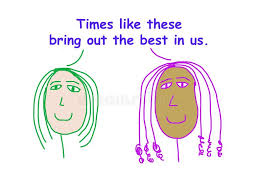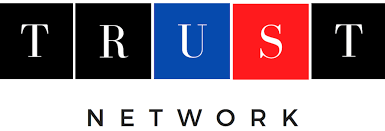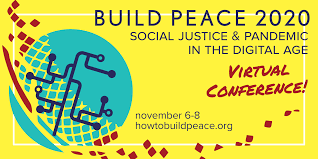
Bringing Out the Best in Us
I spent last weekend at the seventh annual Build Peace conference—when I wasn’t obsessing about election returns, that is. While there, I had to run a workshop on how we could best produce lasting, constructive changes that could overcome the polarization that has gripped my country and paralyzed its government— to put things in their most favorable light.
Even before I got on the virtual airplane to “go” to Cape Town, I had already been worrying about what to write about next. I knew that former Vice President Biden was almost certainly going to win the presidential election. But, I also knew that my country would still be bitterly divided and its democracy increasingly at risk.
Literally seconds before my session began, the wire services called former Vice President the winner in Pennsylvania, hence turning him into the de facto President-Elect. All of a sudden, I had to run a workshop on how we could move from polarization to producing lasting, constructive change in a dramatically different political environment. Not surprising, the workshop participants struggled to figure out what we should next until Michaela Ledesma, Build Peace’s co-founder, issued us all a challenge that could help us do just that.
How can we use this time to bring out the best in us?
Since we only had fifteen minutes left when she issued it, we couldn’t take it very far at the time. Nonetheless, I realized I could use this post to begin a series about how can act on her question.
I have spent most of my time since then thinking through her statement which led me to write this post as an overview of what will be another series of short articles about the ways we can move forward after the election on two levels which I’ll develop here and in the next six posts.
- The lessons I learned from working with Reos Partners at Build Peace which left me more convinced than ever that we need to imagine the future we want to build in the weeks, months, years, and decades to come.
- Five specific action points that the Alliance for Peacebuilding committed itself to at a meeting of its members earlier this week.
My challenge is to find a way of marrying the longer term envisioning and strategical work that Reos promotes with the more immediate challenges facing an organization like AfP. In the end, you can’t fully do one without the other, but blending the two is no simple task.
Even more than was the case with the series I’ve written over the last six months, I’m still trying to figure this one out because the two points seem to be pulling me in contradictory directions which I hope to begin figuring out as I write.
So, bear with me.
As with those other series, I’ll update this post with hyperlinks to each subsequent one once I’ve written it.
Bringing Out the Best in Us
This is the first in a series of seven blog posts on how we can bring out the best in ourselves in the aftermath of the 2020 presidential election and while all the other crises we are living through this year continue to rage. Writing them will be a learning experience for me, because I have a lot of threads to pull together which I will be doing as I read, talk with colleagues, and write. I will add links to the list below as I write.
This first blog post focuses on two quite different directions we could head in now that the 2020 election seems to have been decided.
Reconciliation Now
Democracy is in trouble in the United States and beyond. What can we peacebuilders do to strengthen it?
Instead of focusing on peacebuilding and conflict resolution, per se, the time has come to put the issues that divide us and threaten our democracy on center stage in our work.
Conflict can be both necessary and even productive. It can’t be either unless we take violence out of the equation and get people who disagree with each other to work together.
There are some important and promising movements that are promoting dialogue in the United States. I could hardly disagree, since that is part of what I do for a living. However we need to go beyond dialogue for dialogue’s sake.
The new administration will offer us new opportunities to get peacebuilding and related ideas onto political center stage.
This final post will explore the key action items that grow out of the first six.
Envision the Future
Bringing out the best in us assume that we know what the “best in us” actually means.
The Build Peace conference reminded me that we have to do more than just promote new public policies, however wonderful they might seem. That realization did not occur during my own panel but in a pair of workshops I attended that were organized by Reos Partners.
Some background might help. Over the last twenty years, I’ve learned a lot from my childhood friend, Dick O’Neill, two of whose lessons were driven home by new friends from Reos.
Building on his career as a US Navy officer and then as a consultant who helped Pentagon leaders think outside the clichéd box, Dick helped me see that trying to counter an argument keeps you locked into its basic logic. Instead, you are more likely to mobilize people if you propose a credible alternative by laying out a plausible future that you can work toward together. In the process, he introduced me to scenario planning as a first step in defining the more attractive future goals you then work to turn into reality.
Although I had known about Reos’ work in the Colombian and South African peace processes and its efforts to create systems change through innovation labs in much of the Global South, I hadn’t fully appreciated one of its unique contribution to the use of scenario planning. Others who work in that space (see, for instance, my review of Peter Schwartz’s The Art of the Long View) ask their clients to work with predefined scenarios.
Not Reos. It’s team has a novel take on setting future goals through scenario planning that has tremendous potential for peacebuilders and others who try to chart a new path forward in the post-Trump and (eventually) post-COVID world.
It convenes fairly large and representative groups of stakeholders with opposing points of view and has them design their own scenarios. Then and only then does the Reos team help their clients choose among them. Using the same logic we find among advocates of local peacebuilding, Reos makes the case the very act of collectively defining positive and negative future scenarios can lead adversaries to begin working collaboratively together.
You can get a taste of what they do from one of their promotional videos which I’ll explore in more depth next week .
I’m particularly drawn to the Reos approach because we can’t meet Michaela’s challenge unless disparate groups of people decide together what “that best” that we want to “bring out of ourselves” is. That’s particularly true when it comes to work the Mary Hoch Center for Reconciliation at George Mason University is launching on racial healing and reconciliation about which I’ll also be writing a lot in the weeks to come.
The events of the last few years have driven home how much work we have to do in combatting systemic racism in the United States. The protests since George Floyd’s death have unleashed a flurry of promising initiatives, including the ones we are organizing at GMU. However, we could and should do a lot more to get the people who care about race in the United States to sit down together and determine the kind of society we want to build together. Only after we’ve done that can we hope to bring out the best in us.
In our case, we will be working with local healing and reconciliation projects around the country. These will take many forms, but they all would benefit from the kind of visioning process that Reos asks its stakeholders around the world to engage in.
Smilarly, the Build Peace team is exploring how it could take the Reos model and use it to define the scenarios we want to avoid and those we want to work toward together. The Build Peace team is currently talking with Reos about how we can do so in online as well as geographically defined communities. And, because I’m on Build Peace’s board of directors, I’ll have a lot of fun participating in that project, too.
Seize the Political Moment
The projects Reos gets involved with can and do have immediate results. However, when done best, they do take a fair bit of time and show their greatest impact in a time period that can span a number of years.
Thus, we also have to think about projects we can take on right away while we simultaneously determine what the best in us entails. After all, Michaela reminded us, there is something pressing and perhaps magical about the moment we are now in.
That’s where this week’s initiatives launched by the Alliance for Peacebuilding (Af.) come into play.
At the Alliance for Peacebuilding, we have been exploring scenario planning and other systems and complexity based theories for the last decade or so. At the same time, we also have to represent the interests of our members and peacebuilders in general with policy makers in Washington, the United Government, and other governments around the world.
As a result, as much as we like and use approaches like those developed by Reos, we do have to make shorter term responses, too, when there is a good chance that we can change the system for the better. So, our leaders wrote a statement on the importance of peacebuilding at home. That statement itself marked an important transition for the organization since we were created to foster peace around the world. We have been paying more and more attention to conflict here in the United States in the fifteen years that I’ve worked for AfP. However, this was the most forceful statement we’ve made yet about the need for our community to prioritize work in our own backyard.
There are certainly some avenues that those of us in civil society should pursue in the short run. While this election was by no means a political landslide and the Biden administration will have to navigate power with a Senate which will almost certainly have a Republican majority, it has left us with a more hopeful environment than we’ve had, perhaps, since the euphoria surrounding Obama’s first election twelve years ago.
The Build Peace conference was not the place to discuss those options. We were there to discuss other issues. What’s more, at least two-thirds of the participants were not from the United States.
A first cut at those options for the peacebuilding community came Monday when the Alliance for Peacebuilding convened a Zoom meeting for its staff and the leaders of its member organizations which attracted over seventy participants.
 At it, we agreed on a number of steps and principles that will guide our action in the weeks and months to come and that can also become part of a Reos-style scenario planning process. I’ve edited them a bit so that I can better help readers see how they can be combined with scenario planning and related initiatives over the course of the next six blog posts:
At it, we agreed on a number of steps and principles that will guide our action in the weeks and months to come and that can also become part of a Reos-style scenario planning process. I’ve edited them a bit so that I can better help readers see how they can be combined with scenario planning and related initiatives over the course of the next six blog posts:
- We will continue to support democracy which remains under threat despite the outcome of the American election which was still being challenged by President Trump as I finished this post.
- At the same time, we will have to expand the range of issues peacebuillders focus on to include social, racial, gender, economic equality in an age of pandemics and climate change.
- Through initiatives like the Trust Network and +Peace, we will strengthen our efforts to reduce the tension and violence that have become a part of everyday political life in the United States and beyond.
- Peacebuilding in the United States involves more than simply bringing people on all sides together. That kind of work is critical, but we also have to make progress on the specific issues that have divided our country and the world in recent years, especially those that involve structural inequalities whose origins are generations or even centuries old. In other words, we have to work toward the kind of systemic change Reos Partners talks about.
- We will continue supporting government programs and agencies that contribute to solving those problems at home and abroad and help create new ones when and where we need to. We will work with the new administration where it is and help it include peacebuilding practices and peacebuilding language in more and more of its efforts.
This is by no means a definitive list of what our priorities should be. It also doesn’t speak to specific issues like implementing the Global Fragility Act, determining critical next steps to take on climate change, improving relations with specific countries, or defining the stances we should take take on domestic conflict-related issues.
Nonetheless, the AfP list is a great starting point. In fact, I will be returning to it by considering each suggestion individually in the weeks to come.
The views and opinions expressed in this article are those of the author and do not necessarily reflect the official policy or position of the Alliance for Peacebuilding or its members.
Also published on Medium.


